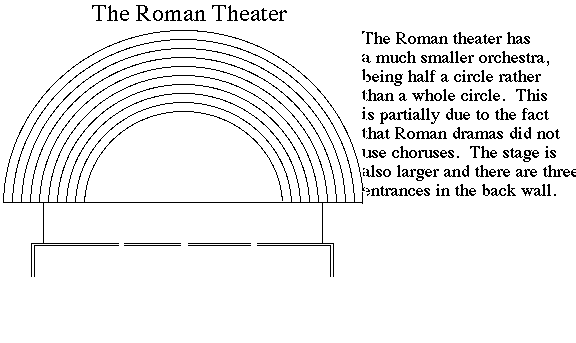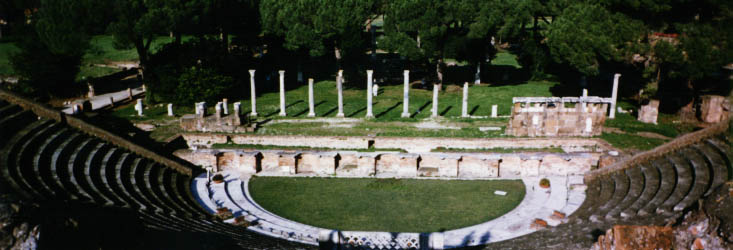
View all the images linked below. First examine the plan of a Roman theater and learn the parts of the theater: seating, orchestra, stage, skene ("scene"). Place your mouse over the plan and it will reveal the plan of a Greek theater. Note the differences between the two. When viewing the remains of the various Roman theaters try to identify the different parts.

An additional difference between Greek and Roman theaters is that Greek theaters were usually built on the natural slope of a hill, taking advantage of the terrain and acoustics. Seats were often cut into the hillside and the audience looking toward the stage would also catch a glimpse of the valley beyond it. The Romans built theaters anywhere, even on flat plains, by raising the whole structure off the ground. As a result, the whole structure was more integrated and entrances/exits could be built into the cavea, as is done in large theaters and sports arenas today. The scaena was as high as the rest of the structure, so the audience could not look out beyond the stage. It also created more of an enclosed atmosphere and may have helped keep out the noises of the city. A tarp could be rigged and moved over the top of the theater to create shade. Note the three entrances built into the scaena.
Question: Give one reason why there are Roman theater next to a hill----------------------------------------
Photo of the theater at Ostia:

Photo by Traci Leach.
Pictures of the material remains of some Roman theaters:
AICT images from Ross Scaife's Roman Art page at VROMA:
Comic mask
fragment from a mosaic Roman Indianapolis Museum of Art, Indianapolis
[small image] - [large image]
Marble relief: theatre set design with three entrance portals
part of a votive work dedicated to Dionysus marble Roman Empire Museo Nazionale Romano, Rome
[small image] - [large image]
]The Great Theatre in Pompeii
interior view showing auditorium seating, orchestra, stage with skena
orig. ca. 2nd century B.C. Roman (Campania) Pompeii, Italy
[small image - [large image]
The Odeon (Small Theatre) in Pompeii
Pompeii: interior view showing auditorium seating, orchestra, stage with skena
orig. ca. 75 B.C. Roman (Campania) Pompeii, Italy
[small image -[large image]
Detail of the Odeon
Pompeii: interior detail; Telamon (Atlantid) figure supporting balustrade by E. parodos
orig. ca. 75 B.C. Roman (Campania) Pompeii, Italy
[small image - [large image]
Theater of Marcellus: view of the exterior and a nice plan of the theater, by Gabriele Gorla
See also: "Marcellus, Theatre of" from Britannica Online [available only to to users from subscribing institutions].
Images from the OSSHE Historical and Cultural Atlas Resource. (All material copyright John Nicols.)
Augustan theater at Arausio (Orange, France.)
[small image] - [large image]
Augustan theater at Emerita (Merida, Spain).
[small image] - [large image]
Roman theater at Vaison les Romains, France.
[small image] - [large image]
Roman theater at Taurominium (Taormina, Italy).
[small image] - [large image]